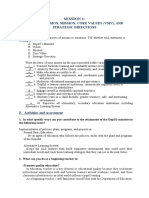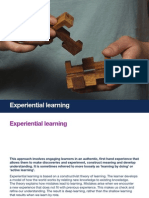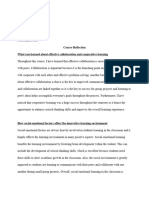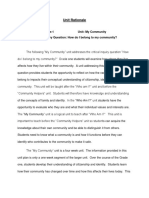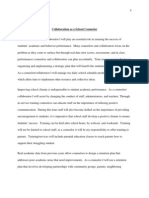Learning Guide A Know How To Learn
Learning Guide A Know How To Learn
Uploaded by
api-288100428Copyright:
Available Formats
Learning Guide A Know How To Learn
Learning Guide A Know How To Learn
Uploaded by
api-288100428Original Title
Copyright
Available Formats
Share this document
Did you find this document useful?
Is this content inappropriate?
Copyright:
Available Formats
Learning Guide A Know How To Learn
Learning Guide A Know How To Learn
Uploaded by
api-288100428Copyright:
Available Formats
Learning
Guide
Supporting Student Development of Competencies:
Know How to Learn
This learning guide shares several strategies and ideas related to
supporting student development of the competency Know How
to Learn. Some of the strategies and ideas shared are ones you
may have already used with your students. The shift is to
become intentional about highlighting/discussing how these
tried and true strategies support the development of one or
more competencies.
This learning guide is designed for use by
professional learning communities, leaders,
learning coaches and teachers, or as a self-paced
study to explore practical strategies to support student
development of Albertas competencies across the
curriculum and in every classroom.
Use this Learning Guide after viewing
Know How to Learn and Alberta Educations
competency indicators related to Know How to
Learn.
Learner Profile: Successful development of the Know How to Learn competency results in a learner who is
resourceful and resilient and engages in ongoing reflective practices. This learner is confident, self-reliant and able to
recognize his/her strengths and areas for growth, and can apply many and varied strategies for deep learning. He/she
optimizes learning through inquiry, discovery, experimentation, and trial and error.
Key Strategies/Ideas:
Help students understand the difference between a fixed
mindset, that intelligence is a static trait (some are smart
and some are not), and a growth mindset, that intelligence
can be developed by various means (Dweck, 2006). Support
a growth mindset by encouraging students to take risks,
embrace challenges, set goals and develop persistence.
Help students become aware of multiple intelligence
(Howard Gardner, 1983). When students understand the
balance of their own multiple intelligence, they can begin
to:
o manage their own learning
o value their individual strengths and
o set goals for areas of challenge.
Encourage students to use graphic organizers, concept
maps, journals and/or interactive notebooks visual
displays that demonstrate the relationships among facts,
concepts or ideas and hold new thinking.
Engage students in self-reflection: How do I learn? What
did I learn? How well did I achieve my goal? What changes
did I have to make to meet my goal? What changes will I
make the next time I do this? Where else can I use these
strategies? Have I incorporated feedback I have received?
How do I know when I have mastered something?
Allow for social interaction to maximize learning.
Acknowledgement:
This Professional Learning Guide was developed by the Edmonton
Regional Learning Consortium and funded through a grant from
Alberta Education to support implementation. It is provided for free
in support of improved teaching and learning under the following
Creative Commons license.
Questions for Reflection and Discussion:
How might you make growth mindset part of everyday
teaching?
Reflect on the culture in your classroom:
o How do you create a culture where mistakes are
considered part of learning, and persistence is
embraced?
o How do you teach students to demonstrate empathy
and respect, and value diversity?
o How do you model those traits when working with your
colleagues?
Graphic organizers and protocols support the development of
the Know How to Learn competency. How might these
tools support the development of other competencies?
What strategies have you used to support student
development of the Know How to Learn competency?
For more information:
Embracing the F Word: Using failure to build resilience and
motivation at school, Reachout.com
Watch Whats Working: Carol Dweck Talks Growth Mindset,
Edutopia
Graphic Organizers, Alberta Education
Protocols Expeditionary Learning, NY State
How to Learn? From Mistakes TED Talk video
The Perils and Promise of Praise Carol Dweck, ASCD
The Provincial First Nations, Mtis, and Inuit Professional Learning
Project
Learner Preference Inventories:
http://education.alberta.ca/media/352661/build.pdf
You might also like
- TIP Module 1 Ans KeyDocument45 pagesTIP Module 1 Ans KeyReven Villarta87% (15)
- EPA Observation EssayDocument4 pagesEPA Observation Essayrehana hanifNo ratings yet
- Working With Emergent Language - Richard Chinn: July 2020Document4 pagesWorking With Emergent Language - Richard Chinn: July 2020Anna IvanovskayaNo ratings yet
- Syllabus: Cambridge International Certificate Early Years Good Practice 5889Document30 pagesSyllabus: Cambridge International Certificate Early Years Good Practice 5889hoxbay999No ratings yet
- Simulation (RDP)Document13 pagesSimulation (RDP)Ambika Suwal0% (1)
- 5co03 Task TwoDocument18 pages5co03 Task TwoAnwar AnsariNo ratings yet
- Gifted Education and Gifted Students: A Guide for Inservice and Preservice TeachersFrom EverandGifted Education and Gifted Students: A Guide for Inservice and Preservice TeachersNo ratings yet
- Unit 21: Inclusive PracticeDocument23 pagesUnit 21: Inclusive PracticeKan SonNo ratings yet
- Learning Guide H Demonstrate Good Communication SkillsDocument1 pageLearning Guide H Demonstrate Good Communication Skillsapi-288100428No ratings yet
- Universal Design For Learning ArticleDocument2 pagesUniversal Design For Learning ArticleNicolas Alejandro Perez Torrico100% (1)
- CCEC Section O Teaching and Learning StrategiesDocument59 pagesCCEC Section O Teaching and Learning StrategiesJamugaleh100% (1)
- Grade 9 Unit Plan - Wagner CatharinaDocument25 pagesGrade 9 Unit Plan - Wagner Catharinaapi-288100428No ratings yet
- 2013 - Farrell - Teacher Self-Awareness Through Journal WritingDocument8 pages2013 - Farrell - Teacher Self-Awareness Through Journal Writingophelia elisa novitaNo ratings yet
- Learning Guide C Identify and Solve Complex ProblemsDocument1 pageLearning Guide C Identify and Solve Complex Problemsapi-288100428No ratings yet
- TPGPDocument2 pagesTPGPapi-453015805No ratings yet
- Universal Design For Learning PARA ESTUDIARDocument3 pagesUniversal Design For Learning PARA ESTUDIARLucero Andrea Mendoza CadenasNo ratings yet
- Module 1Document13 pagesModule 1Charmel AJ S. Bron95% (20)
- Learning & Study Guide for Adult Students: Teacher's ManualFrom EverandLearning & Study Guide for Adult Students: Teacher's ManualNo ratings yet
- Student Centerer Learning Environments ScleDocument1 pageStudent Centerer Learning Environments Scleapi-248611030No ratings yet
- TIP MODULE 1Document59 pagesTIP MODULE 1RASSEL DULOSNo ratings yet
- Module 1Document54 pagesModule 1Estrelita Pajo RefuerzoNo ratings yet
- Module1 Session1Document8 pagesModule1 Session1Leah Rose CandaNo ratings yet
- UNBC Lesson Plan Template EY 2020 2Document6 pagesUNBC Lesson Plan Template EY 2020 2아만다No ratings yet
- Tkes Reflective QuestionsDocument3 pagesTkes Reflective Questionsapi-232371227No ratings yet
- April 25, 2023 - PPT Report (Early Child)Document30 pagesApril 25, 2023 - PPT Report (Early Child)Ciara kaye JarabeseNo ratings yet
- 10 Educational Buzzwords and Their MeaningsDocument2 pages10 Educational Buzzwords and Their MeaningsAnonymous j6GPMfYNo ratings yet
- Establishing Your Advisory Purpose: Barbara Ashcraft WVDE School Counseling Coordinator Office of School ImprovementDocument26 pagesEstablishing Your Advisory Purpose: Barbara Ashcraft WVDE School Counseling Coordinator Office of School Improvementapi-292425886No ratings yet
- Guiding Questions For Co Teaching ObservationDocument3 pagesGuiding Questions For Co Teaching Observationfrankylinares2012No ratings yet
- Learning Guide B Think CriticallyDocument1 pageLearning Guide B Think Criticallyapi-288100428No ratings yet
- Theory Cheat SheetDocument10 pagesTheory Cheat SheetMike DialNo ratings yet
- Grade 1: My CommunityDocument36 pagesGrade 1: My Communityapi-336832480No ratings yet
- Takeaway 4 Reflection and Discussion GuideDocument3 pagesTakeaway 4 Reflection and Discussion Guidebrietome.jfNo ratings yet
- Advocacy PlanDocument4 pagesAdvocacy Planapi-251254104No ratings yet
- A Theory of Effective Computer-Based Instruction For Adults FinalDocument46 pagesA Theory of Effective Computer-Based Instruction For Adults Finalapi-288270761No ratings yet
- Direct Instruction Lesson Plan Template: HistoryDocument3 pagesDirect Instruction Lesson Plan Template: Historyapi-372927823No ratings yet
- I. Session 1Document12 pagesI. Session 1namotangi007No ratings yet
- INCLUSIVENESSDocument5 pagesINCLUSIVENESSrey dumancasNo ratings yet
- Resources - Making Your School Culture More InclusiveDocument11 pagesResources - Making Your School Culture More InclusiveDương Lan AnhNo ratings yet
- Module 1 To Print - 1Document61 pagesModule 1 To Print - 1Lovely Jane AlcoyNo ratings yet
- Integrating Differentiated Instruction and Understanding by DesignDocument25 pagesIntegrating Differentiated Instruction and Understanding by DesignlynjonesNo ratings yet
- Framing Up Inquiry End t2Document7 pagesFraming Up Inquiry End t2api-259958842No ratings yet
- The ARCS Model of Motivating LearningDocument3 pagesThe ARCS Model of Motivating LearningAcevedoNo ratings yet
- Discussion QuestionsDocument4 pagesDiscussion QuestionsteobigmatNo ratings yet
- Planning For InstructionDocument6 pagesPlanning For Instructionapi-404804386No ratings yet
- Learning Guide I Demonstrate Global and Cultural UnderstandingDocument1 pageLearning Guide I Demonstrate Global and Cultural Understandingapi-288100428No ratings yet
- TIP Module-1Document64 pagesTIP Module-1ella mayNo ratings yet
- Workbook For Understanding Educational Policies and PracticesDocument15 pagesWorkbook For Understanding Educational Policies and PracticesZakaria BoutkojjoutNo ratings yet
- Segurida Marites My Teaching PhilosophyDocument3 pagesSegurida Marites My Teaching PhilosophyCaren May BragaNo ratings yet
- TTTL CardsDocument20 pagesTTTL CardsAndy PierceNo ratings yet
- Ued495-496 Crider Lisa Caep2Document2 pagesUed495-496 Crider Lisa Caep2api-434102564No ratings yet
- Differentiated Instruction Assisgment 3Document31 pagesDifferentiated Instruction Assisgment 3Sabrina WoodbineNo ratings yet
- Nurturing Tomorrow's Leaders: Essential Soft Skills Every Child Must LearnFrom EverandNurturing Tomorrow's Leaders: Essential Soft Skills Every Child Must LearnNo ratings yet
- Edse 322 - Habits of Mind Framework For PortfolioDocument7 pagesEdse 322 - Habits of Mind Framework For Portfolioapi-224606598No ratings yet
- Tip Module 1Document79 pagesTip Module 1Mark Anthony AltilleroNo ratings yet
- Udl - Tips For AssessmentDocument5 pagesUdl - Tips For Assessmentapi-675699033No ratings yet
- Universal Design For Learning (Udl) : A Teacher'S Guide: by Allison Posey, Med, Cast, IncDocument7 pagesUniversal Design For Learning (Udl) : A Teacher'S Guide: by Allison Posey, Med, Cast, IncXenon CanonNo ratings yet
- Creativity Course ReflectionDocument15 pagesCreativity Course Reflectionapi-735144451No ratings yet
- Activity 1 LLAMANDOJ John Edzel VDocument4 pagesActivity 1 LLAMANDOJ John Edzel Voblefiaspescuela123No ratings yet
- Teaching Adults-What Trainers Need To KnowDocument12 pagesTeaching Adults-What Trainers Need To KnowSHAMI_KABAB2797100% (4)
- The Six Areas of The PLTS Framework: Independent Enquirers Team WorkersDocument2 pagesThe Six Areas of The PLTS Framework: Independent Enquirers Team WorkersrafaelmariasanchezNo ratings yet
- Unit Rationale: Grade:1 Unit: My Community Critical Inquiry Question: How Do I Belong To My Community?Document32 pagesUnit Rationale: Grade:1 Unit: My Community Critical Inquiry Question: How Do I Belong To My Community?api-336832480No ratings yet
- Collaboration As A School CounselorDocument6 pagesCollaboration As A School CounselorRobin Henderson-RichardsNo ratings yet
- Epse 565i Assignment 4 - Self Assessment 590Document4 pagesEpse 565i Assignment 4 - Self Assessment 590api-543988106No ratings yet
- Possible Interview Questions & AnswersDocument3 pagesPossible Interview Questions & AnswersMohamed EssamNo ratings yet
- Peer Supports ManualDocument53 pagesPeer Supports ManualaacqvstfyapzdruozvNo ratings yet
- Optimistic Thinking: Educator GuideDocument33 pagesOptimistic Thinking: Educator GuideRaluca RaluNo ratings yet
- Direct Instruction Lesson Plan-Jeanette AuberryDocument3 pagesDirect Instruction Lesson Plan-Jeanette Auberryapi-488039747No ratings yet
- Plans/grade-Level/k-4/: Stories The Totems Tell: Bringing Aboriginal Poles To Life. OttawaDocument4 pagesPlans/grade-Level/k-4/: Stories The Totems Tell: Bringing Aboriginal Poles To Life. Ottawaapi-288100428No ratings yet
- Retelling A StoryDocument3 pagesRetelling A Storyapi-288100428No ratings yet
- Grade 7 Health Unit: Personal Health: Incorporating The Alberta Information and Communication Technology CurriculumDocument21 pagesGrade 7 Health Unit: Personal Health: Incorporating The Alberta Information and Communication Technology Curriculumapi-288100428No ratings yet
- Assessment Portfolio FinalDocument14 pagesAssessment Portfolio Finalapi-288100428100% (1)
- Ed 3604 Uap - Wagner CatharinaDocument10 pagesEd 3604 Uap - Wagner Catharinaapi-288100428No ratings yet
- Learning Guide I Demonstrate Global and Cultural UnderstandingDocument1 pageLearning Guide I Demonstrate Global and Cultural Understandingapi-288100428No ratings yet
- Learning Guide B Think CriticallyDocument1 pageLearning Guide B Think Criticallyapi-288100428No ratings yet
- Feap 5 WeeblyDocument6 pagesFeap 5 Weeblyapi-531495599No ratings yet
- Step Prospectus 2021Document48 pagesStep Prospectus 2021saleem rasheedNo ratings yet
- Reading and Reflecting the Text projectDocument6 pagesReading and Reflecting the Text projectr79096124No ratings yet
- DRP Reflective Teacher - S InventoryDocument5 pagesDRP Reflective Teacher - S InventoryFariha Naseer Haral - 28336/TCHR/JVAITNo ratings yet
- Reflection Promotes Professional DevelopmentDocument10 pagesReflection Promotes Professional DevelopmentMuntazir MehdiNo ratings yet
- Continuity of Learning - Dockett&perry PDFDocument102 pagesContinuity of Learning - Dockett&perry PDFfeny dyahNo ratings yet
- Assessment in Learning 2-Study Guide 5Document12 pagesAssessment in Learning 2-Study Guide 5lyssaaustriaNo ratings yet
- Gibbs Reflective CycleDocument7 pagesGibbs Reflective Cyclecarpediem128148No ratings yet
- Competence Assessment Tool For NursesDocument33 pagesCompetence Assessment Tool For NursesApRil Anne BalanonNo ratings yet
- Embodied Knowing - An Experiential Contextual and Reflective ProDocument7 pagesEmbodied Knowing - An Experiential Contextual and Reflective ProLili WenNo ratings yet
- ishioma-professional-portfolioDocument7 pagesishioma-professional-portfolioArchAmoshNo ratings yet
- 8611 Assignment 2 CompleteDocument25 pages8611 Assignment 2 Completematif525No ratings yet
- MoPSE Num Mod 5 FinalDocument44 pagesMoPSE Num Mod 5 Finalvivianchepngetich21No ratings yet
- Module 2 A Community of LearnersDocument12 pagesModule 2 A Community of LearnersJeth ChuaNo ratings yet
- Standard 3 4 - Lesson Sequence Using A Range of IdeasDocument10 pagesStandard 3 4 - Lesson Sequence Using A Range of Ideasapi-321133568No ratings yet
- EDU10 Module 6Document10 pagesEDU10 Module 6Gladys TamañoNo ratings yet
- Fenstermarcher Gary - The Knower and The KnownDocument61 pagesFenstermarcher Gary - The Knower and The KnownClaudia De LaurentisNo ratings yet
- Vietnamese EFL Teachers' Perceptions and Practices of Reflective Teaching As A Tool For Professional DevelopmentDocument11 pagesVietnamese EFL Teachers' Perceptions and Practices of Reflective Teaching As A Tool For Professional Developmentmaihungdong99No ratings yet
- Andrew Jenkins Teaching PhilosophyDocument2 pagesAndrew Jenkins Teaching Philosophyapi-463193103No ratings yet
- An Example of Reflexivity in Reflective Work and Its ImplicationsDocument7 pagesAn Example of Reflexivity in Reflective Work and Its ImplicationsDianne AllenNo ratings yet
- Foe ReflectionDocument4 pagesFoe ReflectionAnusia NagaraniNo ratings yet
- Allama Iqbal Open University Islamabad Department of EducationDocument38 pagesAllama Iqbal Open University Islamabad Department of EducationShoaib MemonNo ratings yet
- Reflection and RefractionDocument24 pagesReflection and Refractionapi-284178491No ratings yet




















